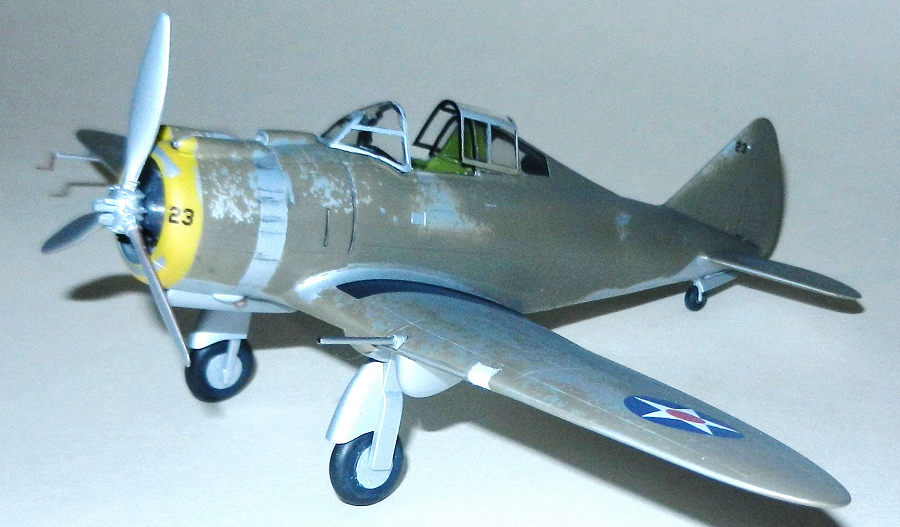
Hobbycraft 1/48 P-35A
| KIT #: | 1553 |
| PRICE: | CAD$30.00 |
| DECALS: | Two options |
| REVIEWER: | Pablo Calcaterra |
| NOTES: |

| HISTORY |
In March 1941 P-35 had been assigned to the USAAC in the Philippines as the most modern fighter available till the arrival of the first P-40Bs (May 1941). Coming from the broken contract with Sweden 53 planes out of 57 were available for three Squadrons. With more planes than pilots now each pilot had an assigned plane. Well liked due to their flying characteristics these P-35s had nevertheless a big weakness: they lacked self sealing tanks.
Green pilots just arrived from the US as part of the fast-growing defensive structure being put in place for the clouds of war were looming. After graduating in P-26s they were transferred to the P-35s and eventually moved to the P-40 squadrons as these were formed and more Curtiss fighters were becoming available.
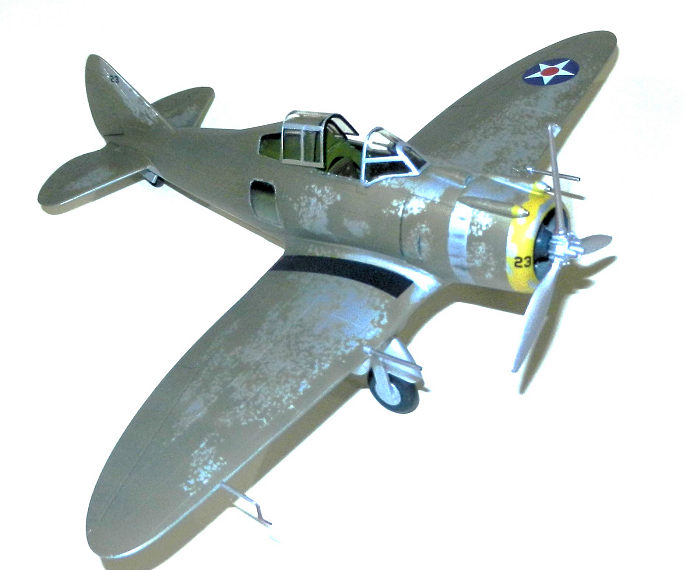 The 3rd PS had a high attrition rate due to accidents with their fighters.
Luckily for them as the 20th
PS was receiving their P-40s they transferred their 35s to the 3rd
PS. By October the 17th
PS was transitioning from their P-35s to the more modern P-40Es. Accidents
continued to reduce the number of Severskys available.
The 3rd PS had a high attrition rate due to accidents with their fighters.
Luckily for them as the 20th
PS was receiving their P-40s they transferred their 35s to the 3rd
PS. By October the 17th
PS was transitioning from their P-35s to the more modern P-40Es. Accidents
continued to reduce the number of Severskys available.
With the growing availability of P-40s the P-35s were being used for gunnery practice and by November they were not considered tactical planes. Their next life would start when all the Squadrons were equipped with P-40s. At that moment the 35s would be transferred to the PAAC (like the 26s in July 41).
Late November two more Squadrons arrived from the US: the 21st and 34th. Till they got their P-40s they were handed the 35s that were available. Based at Nicholls Field the 21st was to received the planes from the 3rd once this one was back from their gunnery training. The 17th also passed on their 35s to the new arrived squadrons. But these found that due to the intensive training the engines were long overdue for an overhaul and the guns were also in pretty bad shape.
Early December the 34th had 22 worn out P-35s at Del Carmen. Their CO was Sam Marett who was doing everything possible to prepare his men, planes and airfield for the inevitable Japanese attack.
When the fateful day arrived (MacArthur’s Pearl Harbor) the chaos and fruitless interceptions of the fighter squadrons in the Philippines are too long to describe here. Suffice to say that the 34th flew a fruitless patrol mission early in the morning and returned to their base without seeing the enemy. At 11 AM they could hear and see the explosions at Clarke Field to their north. Without waiting for orders from their Group commander Marett took his men in 16 x P-35s to the air. Just shortly leaving the ground the CO and his wingman were jumped by Zeroes. The third element leader misidentified the Zeros with A-27 but when the plane behind him started to fire using the guns on the cowling her realized his mistake and successfully evaded the Japanese. Marett’s wingman received some hits but went to the aid of a colleague only to find (like Marett a few moments before) that his guns were not working. Crossland, his best friend, came to his rescue and managed to gain the tail of the Zero only to stall when he tried to fire in a steep turn.
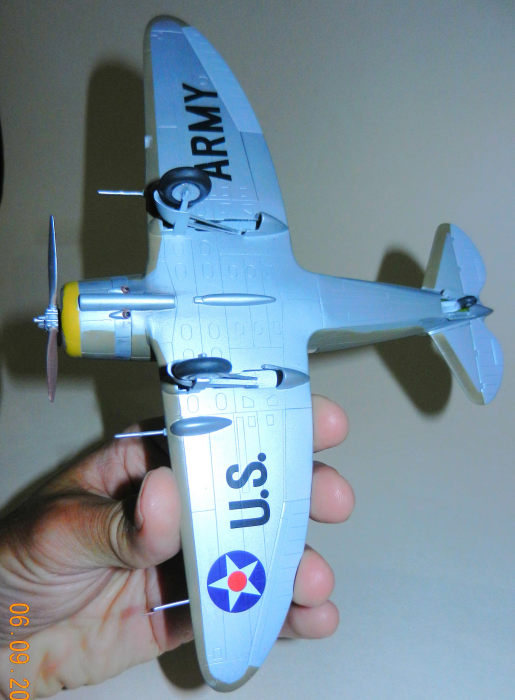 Without Marett the Sqn was now being led by 1st
Lt Brown. He took them to Clark but due to the fact that the planes had no
oxygen they could only fly at 8,000 ft. Suddenly the P-35s found 6 Zeros.
With an advantage of 2:1 (after some of the 34th
planes had returned to their base) the Allied pilots found themselves
fighting the nimble Zeros in their worn out 35 that had their guns out of
commission in many instances. The P-35s were overwhelmed by the experienced
Japanese pilots flying their more capable fighters. Nevertheless, Stewart
Robb could have shot down a Zero who was in turn attacking a fellow pilot.
Robb’s guns hit the enemy plane and smoke and fire started to come out of
the engine. At that moment his windshield and instrument panel got shattered
by the gun of another Zero. While turning the Zero overshoot but climbed
steeply and came down on Robb in a way he had never seen. Hit again by the
Japanese he managed to evade it and crash landed his heavily damaged (more
than 20 hits) P-35. Though none were shot down all of the P-35s had suffered
from Japanese lead intoxication. 2nd
Lt Henry swore he would never go up in a P-35 to fight the Zeros.
Without Marett the Sqn was now being led by 1st
Lt Brown. He took them to Clark but due to the fact that the planes had no
oxygen they could only fly at 8,000 ft. Suddenly the P-35s found 6 Zeros.
With an advantage of 2:1 (after some of the 34th
planes had returned to their base) the Allied pilots found themselves
fighting the nimble Zeros in their worn out 35 that had their guns out of
commission in many instances. The P-35s were overwhelmed by the experienced
Japanese pilots flying their more capable fighters. Nevertheless, Stewart
Robb could have shot down a Zero who was in turn attacking a fellow pilot.
Robb’s guns hit the enemy plane and smoke and fire started to come out of
the engine. At that moment his windshield and instrument panel got shattered
by the gun of another Zero. While turning the Zero overshoot but climbed
steeply and came down on Robb in a way he had never seen. Hit again by the
Japanese he managed to evade it and crash landed his heavily damaged (more
than 20 hits) P-35. Though none were shot down all of the P-35s had suffered
from Japanese lead intoxication. 2nd
Lt Henry swore he would never go up in a P-35 to fight the Zeros.
The 34th was moved to San Marcelino on December 9 as it was assumed that Del Carmen was going to eventually be attacked by the Japanese. While flying there they saw some large planes also heading to their new base. As they were approaching to land the AAA opened up on them and the P-35s had to dodge the friendly fire. Finally landing at San Marcelino they found that those large planes were B-17s. With no mess and basically little in terms of field installations the pilots had to gather money and go out to town to buy food for themselves.
With the Japanese now landing at Vigan, the 35s were sent to Del Carmen to be readied to attack them. Out of the 13 planes available one landed on a ditch and damaged the propeller but the pilots working together managed to straighten the blade using a rock! Twelve planes were to take part in the mission. CO Marett would lead the strafers while Ben Brown would lead the other half as protection. Due to engine problems the Marett had now 4 planes in his flight while Brown had only three. Diving on the Japanese they made their attacks. Judging to be attacking a 10,000-ton cruiser (it was actually a 630-mine sweeper) Marett’s guns hit the anti submarine depth charges stored on the deck. These exploded and the entire ship blew up…taking the wing off from Marett’s 35 who crashed to his death. Crossland, Hal and Pagel attacked till their ammo was expanded leaving two transport ships on fire. Brown came down to also attack the Japanese but he now was also facing engine trouble and returned to Del Carmen with the other 5 planes. For the loss of Marett it was quite a successful attack with the minesweeper sunk, two transport ships on fire and several launches damaged But it was just a mosquito bite on an elephant…
At Del Carmen the surviving P-35s were strafed by the Japanese around noon. This was the end of the 34th PS as seven planes had been destroyed in this last attack, with three more badly damaged and 5 out of commission planes. Brown, now in charge of the Squadron, took his men on foot to the central plain of Del Carmen. What followed is another story. But thus ended the short combat career of the P-35 in the Philippines. They were also credited with two Zeros shot down (apparently by tail code “23”)
| THE KIT |
The much-maligned Hobbycraft kit has been superseded now in 1/48. Nevertheless, it is a quite good representation of the P-35. There’s no detail inside the fuselage where the compartment is (no seat, no nothing).
Decals are for Swedish and USAAC ones. It even has 2 small Japanese kill marks (I doubt there were ever applied to these planes in the field)
| CONSTRUCTION |
 It is
very straightforward. I painted all interior in Interior Green with
instrument panel in black and some details in red with everything
highlighted with drybrushed aluminum. Seat belts were made with Tamiya tape
pained Sand.
It is
very straightforward. I painted all interior in Interior Green with
instrument panel in black and some details in red with everything
highlighted with drybrushed aluminum. Seat belts were made with Tamiya tape
pained Sand.
The kit falls together very well. I followed the instructions including cutting some parts out for the landing gear. The only complaint I have is that the wheels fit too tight inside their retractable “pants”.
I opened the border of attack of the left wing to insert a piece of clear plastic that was then sanded down to recreate the missing landing light. With this the model was ready for the paint session(s)
| COLORS & MARKINGS |
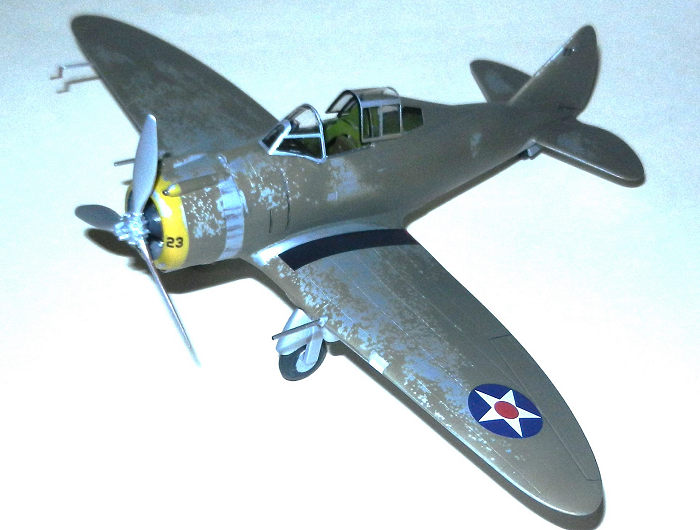 A coat of
light grey Vallejo primer was applied. This was followed by a coat of Vallejo
Aluminum (which had a couple of drops of white to paint the underside of the
movable surfaces).
A coat of
light grey Vallejo primer was applied. This was followed by a coat of Vallejo
Aluminum (which had a couple of drops of white to paint the underside of the
movable surfaces).
I masked the undersides leaving the border of attack exposed as a picture found on line of a P-35 in the Philippines shows three important details: undersides are unpainted (like Tom Cleaver told us in his build of a P-35), the OD wraps around the border of attack of tail and wing and finally the odd-looking rounded fonts for the US ARMY are correct!
Then I used for the first time ever the salt technique to represent the wear of the planes. It was very easy to achieve the worn-out look of these planes that had not been primed before they received the OD (thus the copious rains in the islands washed away the cammo). I corrected some areas with more OD as I had overdone the wear on the top colour.
I masked the engine cowling where the image of “23” in flight clearly shows the chipped paint. For this I used blue tac. Then the area was painted yellow. This image shows that front of the engine cowl is darker than the white of the stars. Therefore, I decided to go with yellow (opinions are split with some places showing this area as white…but there’s no doubt looking at picture…it has to be yellow).
With this the plane was ready for the gloss coat of Vallejo Clear. Having learnt my lesson with my P-26, I gave the plane a 2nd coat after 24 hours thus improving the glossy surface.
The USAAC roundels came from the kit as the stars for the wings. The “23”s I printed in different sizes (larger for engine, smaller for tail) following the proportions seen in the image mentioned above. Added the walkway from the kit and it was done!
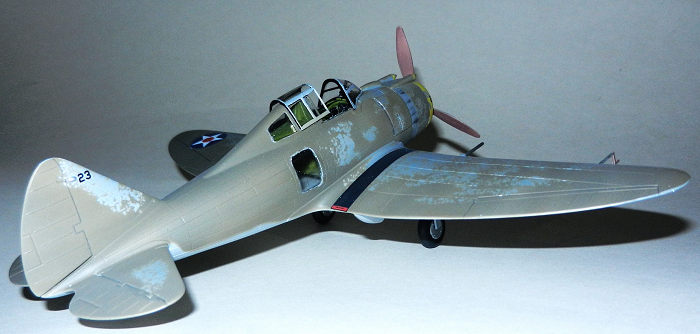 A
coat of Model Master Acrylic Flat Varnish sealed the decals in most of the plane
except for the aluminum exposed areas where I used Semi Gloss MM banish.
A
coat of Model Master Acrylic Flat Varnish sealed the decals in most of the plane
except for the aluminum exposed areas where I used Semi Gloss MM banish.
I attached the wheels, gunsight, windshield. The nav lights were painted in aluminum with clear red and green (tail ones were left in aluminum with a drop of Future). Future covered the landing light giving it a glossy look.
Machine guns were painted in a mix of aluminum and black with the openings painted in black to represent the front of the barrels. Exhausts in rust. The back of the propeller was painted in maroon (front left in aluminum). This one was attached, the hood placed on top of the back portion of the canopy and the P-35 was complete.
| CONCLUSIONS |
Good enough kit for me. My tribute to those Philippines defenders who fought with what they had.
| REFERENCES |
Doomed at the Start (William Bartsch)
Tom Cleaver’s build in MM
23 September 2024
Back to the Previews Index Page
Back to the Previews Index Page